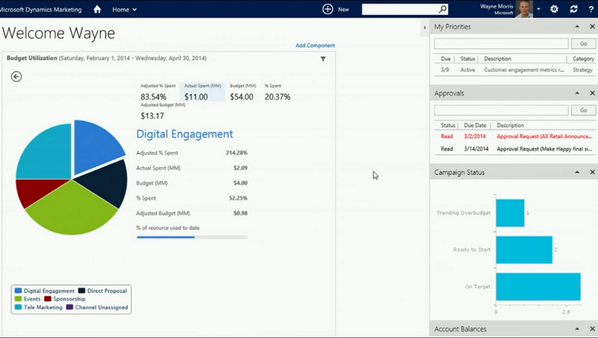ATLANTA – Microsoft Corp.‘s new additions to its business solutions software line with Dynamics Marketing and Social Listening will mean partners won’t have to tap third-party solutions for customers as often, according to one Toronto-based value-added reseller.
Microsoft Gold partner Rimrock Corp. said the upcoming new product releases will be an important piece of their toolkit. For customers who are seeking help with a pain point in marketing especially, the new Dynamics tools could fill gaps that used to be patched by adding in third-party software, says Jonathan Taub, president of Rimrock. For example, Taub has used Click Dimensions as an e-mail marketing solution for Dynamics customers.
“There’s a little bit of drama all the time in terms of upgrades and compatibility,” he says. “With Microsoft’s marketing upgrade, that all goes away.”
Microsoft revealed Feb. 18 that its Dynamics CRM Spring release will include two new modules, Dynamics Marketing and Microsoft Social Listening. Both are rebranding of products that Microsoft acquired in the past two years – Marketing Pilot and Netbreeze. At its annual Convergence conference this week, Microsoft revealed pricing and packaging details for its new software products.
Dynamics Marketing will be included in a new Dynamics CRM Online Enterprise Licence priced at $200 per user per month that includes access to the new Unified Service Desk as well. The Social Listening feature will be added on to the Dynamics CRM Online Professional package at no extra cost per licence. Those using on-premises software must pay another $20 per month per user to access the cloud software.
Beyond just releasing software designed to help marketers do their jobs, Microsoft executives alluded to a new strategy highlighting line-of-business decision makers in keynote speeches and interviews at Convergence this week. It’s no secret that chief marketing officers are gaining more budget to buy technology to drive the business, and it’s a trend Kirill Tatarinov, executive vice-president of Microsoft Business Solutions, says he is excited about.
“We’re seeing this shift because it’s the most common way to reach your customers at mass and turn your customers into brand loyalists,” he says. “We see our role as a unifier of IT and business.”

Kirill Tatarinov runs Microsoft’s Business Solutions division.
That line of business focus surfaces in Microsoft’s design approach to its software products, says Rob Adams, general manager of dynamics for Microsoft Canada. It focused on making the user experience for Dynamics Marketing as intuitive as possible, modelling it after the Outlook design that users reviewed positively.
“User experience is the new currency of technology,” he says. “There is a lot of focus there lately.”

An example of the dashboard in Microsoft Dynamics Marketing.
But beyond the user experience is the functionality of the product. Features like campaign management, event organization, and impact measurement look good in the Microsoft-conducted demoes on stage. But Microsoft is slower to market than other competitors that have already been offering marketing components to CRM or ERP suites.
That’s a problem for analyst Ray Wang, founder of Constellation Research, who describes Dynamics Marketing as a basic marketing tool.
“We think it’s two or three releases away from being competitive to an ExactTarget or a HubSpot,” he says. “The basic campaign management is there.”
Still, Microsoft understands what it needs to build, Wang says. It needs to get to a point where every touch point with the customer can deliver a marketing opportunity. Plus, the Social Listening product is more impressive in the way it brings intelligence to social listening and includes native language processing across many languages.
But if you ask Tatarinov about those same products, he has a different point of view.
HubSpot and ExactTarget are “niche technologies serving specific needs. Our approach to marketing and serving the needs of the CMO is way broader than that,” he says. “Its an approach that says you’re able to define the entire marketing strategy through technology.”
For Rimrock’s Taub, Microsoft is getting into the marketing game at the right time. Though he wonders for what size of business the marketing software will work best.
“In my mind, it’s a bit of a land grab right now,” he says. “If you’re verticalized and you get in early, you will spread. But if you’re not building out the right solution now it’s going to be hard to catch up.”
Microsoft is eventually working towards helping marketers manage campaigns across multiple channels and report on their return to the marketing investment, Tatarinov says. That’s something no one is doing today, and Microsoft will be able to help its customers do it.
After all, the lack of marketing hasn’t hindered Dynamics CRM growth so far. It’s now enjoyed 38 straight quarters of double-digit growth, according to Microsoft.



